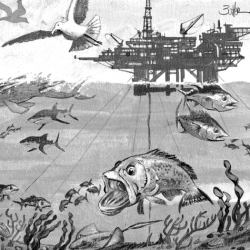
This issue's articles are available below.
ELI Members may login to read and download current and past issues of the Forum.
Not a member? Join now!

LEAD FEATURE ❧ The regulatory, programmatic, and operational safeguards necessary to exploit America’s rich fossil-fuel reserves under the Outer Continental Shelf, including lower-carbon natural gas, can be accessed safely by employing new best practices, and lessons learned since the gulf oil spill.
With SIDEBARs by representatives of the Interior Department, the Spill Commission, and a Gulf Coast citizens organization

CENTERPIECE ❧ Environmental law is informed by science, but policymakers are beginning to understand — and embody in habitat protection regimes and responses to crises like climate change — sources of local and indigenous knowledge, often passed down orally from generation to generation.

COVER STORY ❧ The Clean Water Act’s state revolving fund program was created in 1987 to finance wastewater treatment plants — but it could provide the funding for so many other environmental improvements if we use creative incentives to tackle 21st century problems.
With a SIDEBAR by a representative of Pennsylvania’s state revolving fund

BOOK EXCERPT ❧ While water management is the great lesson of what Phoenix and environs have done well, sustaining urbanism in central Arizona requires continued creative thinking about the resource, complex balancing between competing uses, and the kind of committed collective decisionmaking that was a hallmark of bringing civilization to the desert.

HEADNOTE ❧ Europe is tense with the outflow of migrants from Syria and other Middle Eastern countries, torn by civil war and drought. They are not the only persons who can be referred to as environmental refugees. Scientists expect the frequency and extent of environmental displacement to increase as the effects of climate change become more intense. The United Nations High Commissioner for Refugees estimates that climate change will displace up to 250 million people over the next 35 years, many permanently. What policies, legal regimes, and institutions do we need to create or improve to help environmental refugees find new lives for themselves and their families?
Ominous rumblings: are stricter EPA stormwater permits ahead?
Implementing the new cooling water protections for power plants.
Cities are talking trash again — and this time it's zero trash.
Built infrastructure and climate change in the American Southwest.
Agencies start worrying that deference may no longer be their just due.
How will Brexit affect the U.K.'s EHS law? Britons may not like it.
A key challenge for sustained success of the Paris agreement.
Maps of a future United States paint a dire picture of climate change.
On suburban sprawl, reconsidered.
Institute is a key player in quadrennial international conclave.
Changing maps, changing coastal laws and policies.
Scott Fulton on ELI’s new strategic plan.